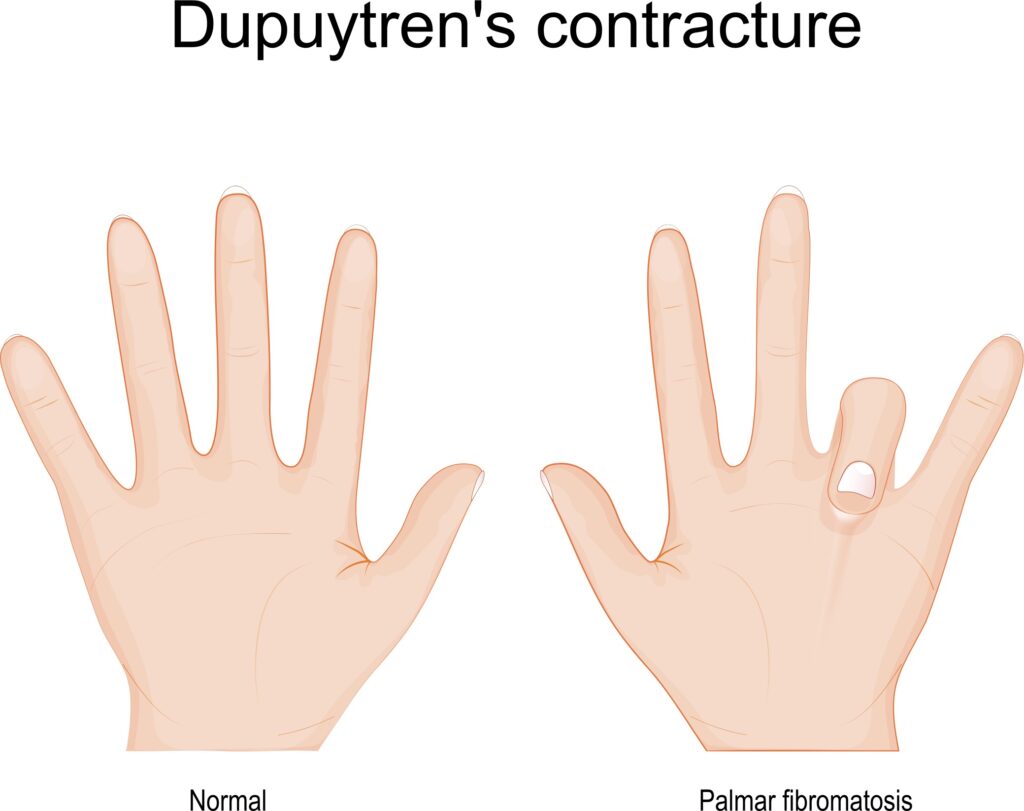Dupuytren’s contracture, or Dupuytren’s disease, results from the abnormal thickening of the layer of tissues under the skin. So, how long does dupuytren’s contracture take to develop? Let’s answer your questions.
The disease affects the palm at the base of the fingers. The thickened area develops into a hard lump or thick band. As the disease progresses, one or more fingers may curl or pull in towards the palm or sideways. The condition mostly affects the ring and little fingers and may affect one or both hands. Many people ignore the disease until the curling makes it impossible to perform daily tasks.
How Long Does Dupuytren’s Contracture Take to Develop?
Like many conditions that affect the hand and upper limbs, Dupuytren’s contracture progresses slowly over years and even decades. There is, however, a limited amount of research to determine the average span for the disease’s progression. Most people who develop Dupuytren’s contracture are men over 50. If someone develops the condition when young, it tends to progress much more quickly and is more severe. Otherwise, most people tend to have mild symptoms that don’t require treatment.

What are the Early Signs of Dupuytren’s Contracture?
Most cases of Dupuytren’s contracture first appear after the age of 40. The first sign is a lump in the palm of the hand, which most people mistake for a callus. In fact, most patients assume that they’ve done something with their golf or tennis grip or think they have a typical callus and don’t pay much attention to it.
Besides the lump, you may also experience burning, itching, and tenderness in the area. Most patients describe the tenderness as similar to a bruise or cut in the last stages of healing. It can be misdiagnosed as tendonitis, although it affects the layers of tissue underneath the skin rather than the tendons.
At this stage, the lumps are referred to as nodules. They may go away on their own in some people. In others, they tend to remain in place for months or years before anything else happens. Treatments like steroid injections only slow down the progression temporarily.
What are the Symptoms of Late-Stage Dupuytren’s Contracture?
The condition tends to progress more rapidly in men than in women and those who have both hands affected. As the disease progresses, the lumps or nodules thicken into cords that may feel like strings underneath the skin. The skin in that area begins to shrink and feel lumpy.
What happens underneath the skin is the same thing that happens when an open wound heals. The wound triggers the shrinking and scarring process, and the body gradually pulls the skin edges together to help close the wound. However, in the case of Dupuytren’s contracture, this process is activated inappropriately. So, when do the symptoms begin causing problems? Dupuytren’s contracture can develop slowly for years without causing any issues.
Most patients begin noticing changes when the shrinkage causes contraction that’s enough to limit finger motion. You tend to notice a tightness in the fingers when it becomes difficult to straighten them. As the disease progresses, the contraction can make it difficult to use your hand.
How Can You Slow Down the Progression of Dupuytren’s Contracture?
Unfortunately, it’s not possible to slow down the disease progression. Studies have looked at several options like steroid injections, vitamin E, hand therapy, radiotherapy, massage, and splinting, but the results have been inconclusive regarding slowing down the disease progression.
What Aggravates the Progression of Dupuytren’s Contracture?
While the causes of Dupuytren’s contracture are unknown, certain risk factors increase your chances of developing the disease and progressing rapidly. People with type 2 diabetes, those who smoke, consume alcohol, and take certain seizure medications are at higher risk for Dupuytren’s contracture.
If you have a family history of Dupuytren’s contracture or have Scandinavian or Northern European ancestry, there is a higher chance you might develop the disease in the future.
if you are experiencing symptoms that you suspect might result from Dupuytren’s contracture, book a consultation today at the Harley Clinic to discuss your treatment options before the disease progresses further.
We’ve also created a comprehensive plastic surgery statistics guide on the most popular cosmetic procedures in the UK.













